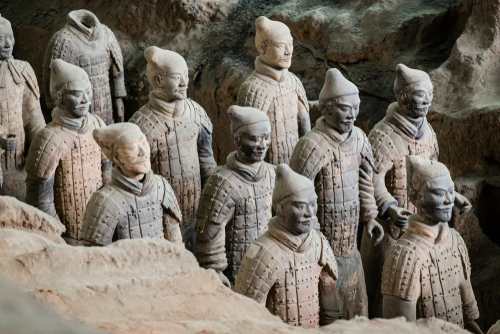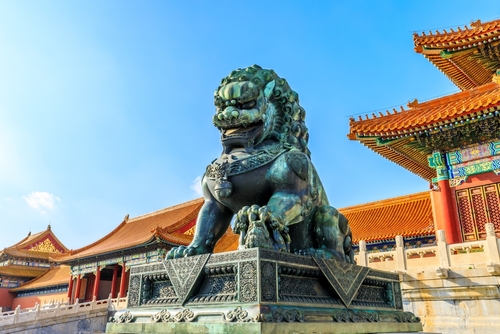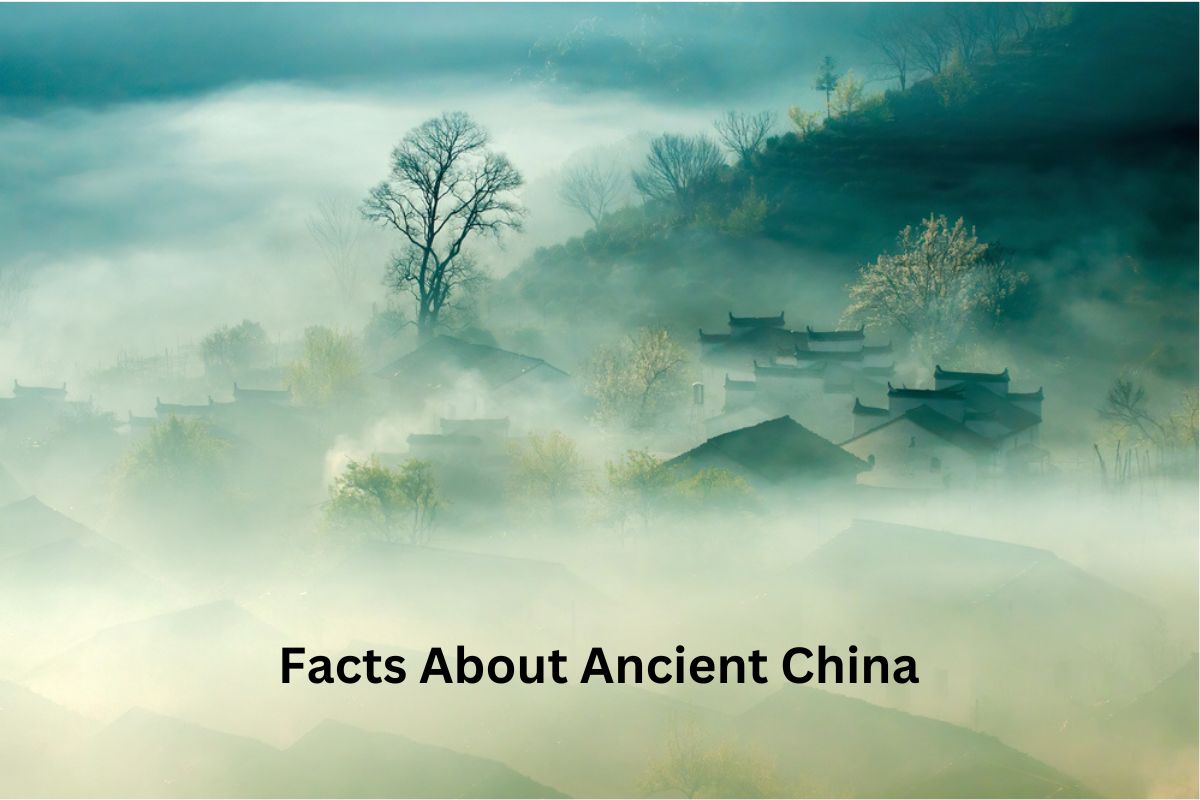Ancient China, with its origins stretching back thousands of years, stands as one of the world’s earliest and most enduring civilizations.
Nestled between mountains, plateaus, and seas, it blossomed along the fertile banks of the Yellow and Yangtze Rivers.
From this cradle emerged pioneering inventions, profound philosophies, and dynastic legacies that have shaped not only East Asia but the entire world.
Renowned for its Great Wall, the poetic verses of the Tang Dynasty, the invention of paper, and the moral teachings of Confucius, this ancient civilization’s tapestry is rich with innovation, culture, and a deep understanding of humanity and nature.
Ancient China Facts
1. Dynasties like Shang, Zhou, Qin, Han, and Tang ruled Ancient China
Ancient China was ruled by several dynasties, each having its unique impact on the culture and development of the civilization.
Some of the most notable dynasties include the Shang, Zhou, Qin, Han, and Tang:
- Shang Dynasty (c.1600–1046 BC) – Recognized as one of China’s earliest dynasties, it was characterized by its bronze works, oracle bone script, and the development of a complex social structure with defined classes.
- Zhou Dynasty (c.1046-256 BC) – The longest-ruling dynasty in Chinese history, it introduced the concept of the ‘Mandate of Heaven’ as a justification for rule. The Zhou era also saw the flowering of Chinese philosophy, including Confucianism and Daoism.
- Qin Dynasty (221–206 BC) – The Qin Dynasty, although short-lived, had profound impacts. Qin Shi Huang, its first emperor, unified the warring states into a single Chinese empire. He standardized measures, currency, and writing scripts.
- Han Dynasty (206 BC – 220 AD) – The Han Dynasty was a golden age of cultural, economic, technological, and political advancements. The Silk Road was established during this time, fostering trade and cultural exchange. The dynasty also saw the codification of Confucianism as a state philosophy.
- Tang Dynasty (618–907 AD) – Another golden age, the Tang Dynasty was marked by its cosmopolitan culture, profound poetry, and advancements in trade, art, and science. The capital, Chang’an (modern-day Xi’an), was one of the largest and most sophisticated cities in the world.

2. The Great Wall was built starting from the Qin Dynasty
Originally, multiple walls and fortifications were built by various warring states to defend their territories. When Qin Shi Huang unified China, he connected and expanded these walls, laying the foundation for what would later be known as the Great Wall.
Also Read: Great Wall of China Facts
Successive dynasties, especially the Ming, further built upon and renovated it. The Wall was not only a defense against northern invaders but also a means of border control, allowing the imposition of duties on Silk Road trade.
3. Ancient Chinese invented paper during the Han Dynasty
Traditionally credited to Cai Lun in 105 AD during the Han Dynasty, the invention of paper marked a revolutionary moment in global history. The process involved macerating plant fibers in water, draining the pulp on a woven mesh to form a sheet, and then drying it.
The availability of paper greatly facilitated the spread of literature, knowledge, and bureaucratic administration in ancient China.
4. The Silk Road connected China to the Mediterranean
An intricate network of trade routes, the Silk Road was central to cultural, commercial, and technological exchange between the East and West.
Also Read: Facts About the Silk Road
Established during the Han Dynasty under Emperor Wu, it connected China with regions such as India, Persia, Arabia, and the Roman Empire. While silk was a primary trade item, the route also facilitated the exchange of spices, metals, gems, and even ideas like religion and technology.
5. Confucius’s teachings influenced Chinese culture
Founded by Confucius (Kong Fuzi) during the late Zhou period, Confucianism emphasizes familial respect, moral integrity, righteousness, and proper social relationships. It’s not just a philosophy but a way of life, deeply ingrained in Chinese culture.
The Five Classics, central to Confucian teachings, were used for centuries as the basis for education and government examinations in China. Confucian ideals have played a pivotal role in shaping governance, societal structures, and personal interactions in East Asian civilizations.

6. The Terracotta Army was buried with Emperor Qin Shi Huang
Discovered in 1974 near Xi’an, the Terracotta Army is a vast collection of life-sized clay sculptures representing the armies of Qin Shi Huang, the first Emperor of China. These statues, numbering in the thousands, were meticulously crafted to serve as an afterlife guard for the Emperor.
Also Read: Facts About the Terracotta Army
They include infantrymen, archers, cavalry, charioteers, and even officers. Each figure is distinct, with varying facial features, hairstyles, and attire. Alongside soldiers, there are also terracotta horses, chariots, and non-military figures like acrobats and musicians.
The craftsmanship and detail in these sculptures reflect the immense resources and sophistication of Qin Dynasty artisans.
7. The Chinese zodiac has a 12-year cycle with animal signs
The Chinese zodiac is a classification scheme based on a 12-year cycle, with each year associated with a specific animal sign: Rat, Ox, Tiger, Rabbit, Dragon, Snake, Horse, Goat, Monkey, Rooster, Dog, and Pig.
The zodiac plays a significant role in Chinese culture, influencing people’s lives, including decisions about marriage, business, and more.
It’s believed that people born in a particular animal year will exhibit characteristics of that animal. For instance, those born in the Year of the Tiger are considered brave, competitive, and unpredictable.
8. Ancient China invented gunpowder
One of the famed “Four Great Inventions” of ancient China, gunpowder, or black powder, was discovered by Daoist alchemists while they were searching for an elixir of immortality. Its earliest compositions were a mix of saltpeter (potassium nitrate), charcoal, and sulfur.
Initially used for medicinal and mystical purposes, its explosive properties were eventually harnessed for military applications. By the Tang Dynasty, it was used in flamethrowers, and by the Song Dynasty, in bombs and eventually firearms.
The knowledge of gunpowder spread to the Islamic world and then to Europe, radically transforming warfare globally.
9. Oracle bones from the Shang Dynasty are early examples of Chinese writing
Predominantly used during the Shang Dynasty, oracle bones are pieces of turtle shells or animal bones used for divination. Questions about the future, from weather predictions to military outcomes, were inscribed on these bones. Heated metal rods were then applied to them, causing cracks.
Diviners would interpret these cracks to predict the future or seek guidance from ancestors and deities. The inscriptions on oracle bones represent some of the earliest known forms of Chinese script, providing invaluable insights into the Shang Dynasty’s politics, economy, culture, and religion.
10. China introduced inventions like the compass, paper money, and printing
Ancient China was known for several inventions that changed the world, including the compass, paper money, and printing:
- Compass: Initially, the ancient Chinese compass was not used for navigation but for geomancy and fortune-telling. It was based on the principle of magnetism. By the Song Dynasty, its navigation potential was recognized, revolutionizing sea travel and trade.
- Paper Money: The Tang and Song Dynasties saw the first use of paper currency in the world. It was introduced to reduce the need to carry heavy metal coins over long distances.
- Printing: While woodblock printing existed earlier, the Song Dynasty’s Bi Sheng invented movable type printing around 1040 AD. This innovation made the production of books and documents more efficient and was a precursor to mass communication revolutions in later centuries.

11. Buddhism entered China around the 1st century AD
Although Buddhism originated in India during the 6th century BCE with the teachings of Siddhartha Gautama (Buddha), it made its way to China around the 1st century AD, primarily via the Silk Road.
Over time, it became deeply intertwined with Chinese culture, adapting to and influencing local customs and philosophies. This led to the emergence of unique Chinese Buddhist schools such as Chan (which evolved into Zen in Japan).
Chinese Buddhist monasteries became centers of learning, culture, and art. The spread of Buddhism also resulted in architectural wonders, like the Longmen and Yungang Grottoes, filled with intricate Buddhist carvings and statues.
12. The civil service examination system selected administrative candidates
The civil service examination system was an essential institution in ancient China, beginning notably with the Sui and Tang Dynasties and reaching its zenith during the Ming and Qing Dynasties.
The exams were designed to select the best candidates for government posts. Grounded in Confucian classics, they emphasized poetry, essay writing, and knowledge of Confucian texts.
This system provided a relatively meritocratic means of social mobility, where even individuals from modest backgrounds could rise to prominent positions with a successful examination performance.
13. Ancient Chinese were pioneers in rice cultivation
Rice is a staple food for a significant portion of the world’s population today, and ancient China played a pivotal role in its cultivation and propagation. The Yangtze River basin provided fertile ground for wet rice cultivation, which began as early as 7000 BCE.
Over millennia, the Chinese developed intricate agricultural technologies and systems for water management, enabling them to support large populations and foster urban growth. The techniques they developed for rice farming significantly influenced agricultural practices across East and Southeast Asia.

14. Acupuncture is a practice from traditional Chinese medicine
Acupuncture, a significant branch of Traditional Chinese Medicine (TCM), involves the insertion of thin needles at specific points on the body to treat a variety of ailments, from pain relief to balancing the body’s vital energies.
The foundational text for acupuncture is the “Huangdi Neijing” (Yellow Emperor’s Inner Canon), dated around the 2nd century BCE. This practice is based on the concept of “Qi” (vital energy) and the Yin-Yang balance. Over time, acupuncture spread to various parts of Asia and, more recently, to the West.
15. The traditional Chinese calendar is lunisolar
The traditional Chinese calendar is lunisolar, which means it incorporates both the moon’s phases and the solar year’s length. This complex calendar system was used to determine agricultural activities, religious ceremonies, and traditional festivals, like the Lunar New Year (Spring Festival).
The calendar divides the year into 24 solar terms, based on the sun’s position in the zodiac, guiding farming activities. Months begin with the new moon, and a leap month is occasionally added to align the lunar and solar years.
